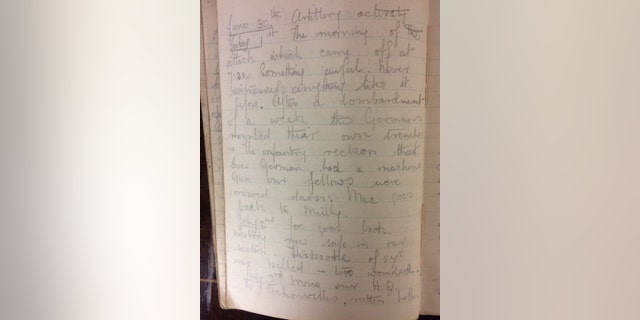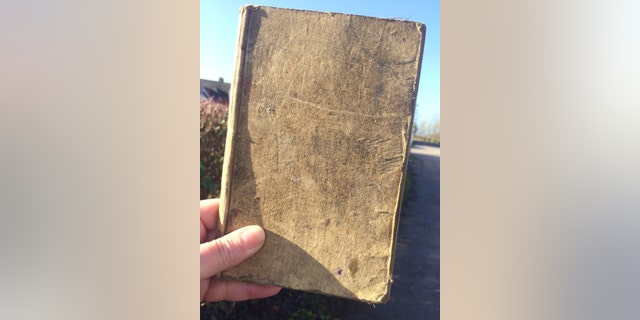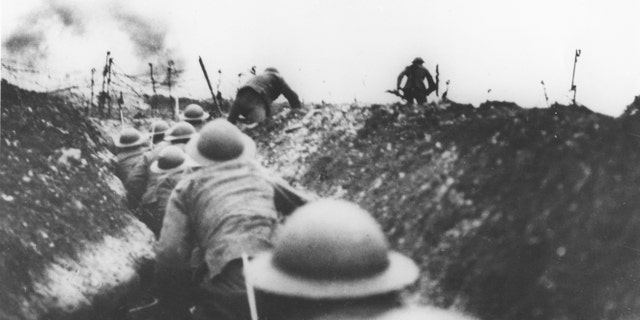No products in the cart.
‘War to end all wars’: How World War I still resonates today
As the world marks the 100th anniversary of the armistice that ended World War I, the National World War I Museum and Memorial serves as a reminder of the sacrifices U.S. troops made in ‘The Great War.’ Eric Shawn reports from Kansas City, Missouri.
A British soldier’s battered World War I diary recounting the bloody Battle of the Somme has been discovered in a U.K. barn.
The diary, which was written in pencil by Private Arthur Edward Diggens of the Royal Engineers, starts on Feb.13, 1916 and ends on Oct. 11 of that year. His diary entry for July 1, 1916, describes the first day of the Battle of Somme.
“Something awful,” he wrote. “Never witnessed anything like it before. After a bombardment of a week the Germans mounted their own trenches and the infantry reckon that every German had a machine gun.”
THIS BULLET-SCARRED BIBLE ‘SAVED THE LIFE’ OF A WORLD WAR I SOLDIER
“Our fellows were mowed down,” Diggens added.

The diary entry for the first day of the Battle of the Somme on July 1, 1916.
(Hansons)
Hansons Auctioneers in the U.K. will be auctioning the diary on March 20.
The battle, which lasted until Nov. 18, 1916, was a massive joint operation between British and French forces that attempted to break through German defenses on the Western Front. More than 1 million British, French and German troops were killed, wounded or captured in the action, according to the Imperial War Museum in London.
WORLD WAR I SOLDIERS SEEN ARRIVING IN EUROPE TO FIGHT ALONGSIDE ALLIES IN RARE PHOTOS
The museum explains that the first day of the infamous battle resulted in more than 57,000 British casualties, of whom 19,240 were killed, making it the bloodiest day in British military history. Auction house Hansons notes that a soldier was killed every 4.4. seconds during the initial attack.

The battered diary was kept by British soldier Arthur Edward Diggens. (Hansons)
Diggens’ diary was in a box found in a barn in Leicestershire, which is in England’s Midlands region. Other unrelated military items were also in the box, according to Hansons. “The owner had no idea who any of the items related to but said his mother had been the recipient of old family heirlooms,” said Hansons’ expert Adrian Stevenson, in a statement. “It’s a complete mystery how this Somme diary ended up in the Midlands, particularly as Arthur was born in London. I’m just relieved such an important piece of military history has been found and can now be preserved.”
After its discovery in the barn, the diary was brought to a Hansons valuation event. Stevenson said that, when he saw that the diary ended abruptly on Oct. 11, 1916, he feared the worst for Diggens. “Because of this we feared Arthur must have been a casualty of the conflict but my research proved otherwise,” he explained. “Not only did he survive the First World War, he returned to his loved ones in England and became a husband and father.”
WORLD WAR I POSTERS OFFER UNIQUE GLIMPSE INTO SOLDIERS’ STORIES 100 YEARS AFTER THE ARMISTICE
“Happily, he went on to marry his wartime sweetheart Alice (nee Phillips) in 1919 and was soon a proud father,” Stevenson added. “Alice gave birth to a son in 1920 – also called Arthur.”

Soldiers from the Royal Irish Rifles in a communication trench on the first day of the Battle of the Somme, July 1, 1916.
(Photo by: Photo12/Universal Images Group via Getty Images)
The diary has a guide price of $390 to $521.
Before fighting on the Western Front, Diggens took part in the Gallipoli campaign in Turkey, which resulted in defeat for the allies. “Sadly, a Gallipoli diary also penned by Arthur has been lost. He posted it home but it never made it,” Stevenson said. “We also know why his diary ended suddenly. Alice sent him a new address book which he used as a diary from Oct 1916. That, too, has been lost.”
WORLD WAR I: 100 YEARS ON, THE US REMEMBERS THE END OF THE ‘GREAT WAR’

Militaria expert Adrian Stevenson of Hansons Auctioneers holds the diary written by British World War I soldier Arthur Edward Diggens.
(Photo by Jacob King/PA Images via Getty Images)
Other remarkable World War I artifacts have emerged in recent years, such as a Bible marked with bullet holes from a German machine gun that helped save the life of a British soldier.
In 2018, rare photos surfaced of American troops arriving in Europe to fight alongside the allies in World War I.
CLICK HERE TO GET THE FOX NEWS APP

British soldiers leaving a trench to attack on the Somme, 1916.
(Photo by Photo 12/ Universal Images Group via Getty Images)
Over 700,000 British troops were killed during World War I and almost 1.7 million were wounded, according to British War Office data. Around 6 million British troops were mobilized in the conflict. In total, the war resulted in the deaths of 13 million military personnel and left 21 million more wounded, according to the Commonwealth War Graves Commission. World War I is among the deadliest wars in modern history.
Follow James Rogers on Twitter @jamesjrogers


